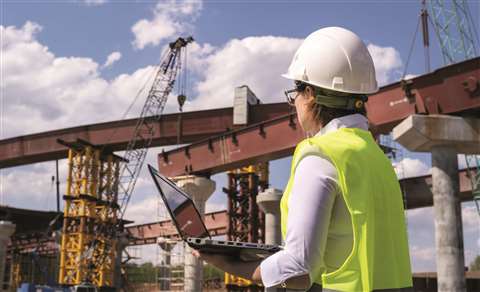Are construction jobs for the boys?
14 March 2022
Construction was one of the only industries where the number of jobs held by women increased during the pandemic. Lucy Barnard finds out why and what employers can do to recruit more women during the “she-cession”.
Holly Price, a director at British demolition firm Keltbray, struggles to remember her working life before the pandemic.
 The pandemic has brought an increasing number of women to the construction industry (Photo: adobe images)
The pandemic has brought an increasing number of women to the construction industry (Photo: adobe images)
“I don’t know how I managed to physically get to so many meetings and to travel so much,” says the director of skills and communities, an explosives engineer by training who, until recently, also acted as president of the National Federation of Demolition Contractors.
“The pandemic has showed us all that we can use technology like Zoom and Teams and I think that has been really beneficial for my work-life balance,” she says. “Now, if I can get online, I can work.”
Price, who started her career in the demolition sector aged 17, trained as an engineer and worked her way up to become the first female explosives expert in Europe in the sector, also works to promote diversity and attract newcomers of all backgrounds to the sector which is typically seen to have one of the most macho cultures in construction.
“I would argue that the pandemic is a golden opportunity to re-balance the construction industry as a whole,” Price says. “In the past construction companies have not always approached jobs with flexibility in mind. We haven’t questioned whether it is necessary to have every member of a team on site for ten hours a day. Covid has proved that some people can work remotely.”
 Holly Price of demolition specialist Keltbray
Holly Price of demolition specialist Keltbray
Although she stresses that it is still too early to really know what the full effects of the pandemic have been on everyday life and that many demolition jobs by their very nature must be performed on site, Price says that the restrictions forced on firms could provide a very much needed kick to help the industry attract and retain more women.
“If you had asked about flexible working two years ago, I think most employers wouldn’t have understood what you were talking about and if they did, they would have said absolutely not,” she says. “Presenteeism has been a big problem in the construction industry.”
“Things were beginning to change before covid, but the pandemic has meant that people are more open to opportunities in the sector,” says Price.
Price’s view seems at odds with the situation at the beginning of the pandemic where more women than men dropped out of the workforce in order to buffer a sudden loss of childcare and shoulder the burdens of home schooling, which created what some economists have dubbed a “she-cession.”
Certainly, the need for more women to enter and remain in construction industries across the developed world is painfully clear. Before the pandemic, McKinsey estimated that women make up just 12% of the global construction industry – and only around 8% in the EU.
Even in Sweden, a country which boasts one of the first feminist governments in the world, men comprise 89.8% of the construction industry while women only account for 10.2%.
And, for site-focused roles, they tend to comprise a considerably smaller percentage of workers.
Post-pandemic boom to lead to more diversity
Nevertheless, experts in Sweden say the pandemic is helping existing efforts to diversify the industry.
 Elin Kebert of the Swedish Construction Federation
Elin Kebert of the Swedish Construction Federation
“The pandemic has been an opportunity for the Swedish construction industry to move forward with women’s issues,” says Elin Kebert, competence expert at the Swedish Construction Federation.
“The construction industry in Sweden has had a very macho culture – if you feel ill, take an aspirin and go to work. Man up. But with the start of the pandemic, I think it was very important for many workers to hear our [then-prime minister], a man with a strong trade union background, saying the opposite. If you’re sick, stay home. If your kids are sick, stay home. The Swedish covid strategy does affect attitudes and is helping to make the industry a better and more flexible place to work for women – and men.”
Kebert says that since the start of the pandemic the number of applicants to higher vocational education programmes backed by the Swedish Construction Federation seeking to fast-track older professionals into site manager positions have increased rapidly. In 2021, 32% of the 5,494 students that started a “Higher VET” programme within construction and engineering were women.
Construction labour shortages in Sweden
“The post-pandemic boom has definitely created a labour shortage in Swedish construction,” she says. “There are building and construction projects going on throughout Sweden so employers are competing to hire skilled construction workers. Employees are able to choose where to work – both men and women are saying, why should I travel long distances to big building sites when I can work close to home, be an active parent and not miss my kid’s dance class. Young professionals want a better work/life balance. “
Women are mostly attracted by the career opportunities and good wages,” Kebert says. “Building sites are usually operating at the times that day care centres are open. And the work gives them a chance to develop highly desirable and transferable skills.”
Susan Moir, research director for the US-based Policy Group on Tradeswomen’s Issues (PGTI), points out that the low proportion of women working on construction sites is only a problem in rich countries where construction workers stand to make good money compared with other non-skilled and semi-skilled jobs.
Raising the number of minorities and women in construction
She says that in these particular areas, organisations like hers, have been pursuing a strategy of encouraging government agencies and contractors to
 The gender pay gap has historically been stark in construction (Photo: adobe images)
The gender pay gap has historically been stark in construction (Photo: adobe images)
include agreements in their construction contracts requiring that a proportion of the total amount of work is done by women and minorities. This is then monitored, usually on a monthly basis. Then, if the monitoring committee finds that women and minorities are not being offered enough work, they can call in the manager in question for a meeting. If no improvement is made after several meetings then the owner has the right to initiate fines.
Moir says this “integrated supply and demand” model is already such a success that the team is hoping to export the model to yet more cities across the US and beyond. A delegation of North American tradeswomen to London has already been planned next year where Moir and her colleagues plan to exchange best practice with developers, contractors, unions and community groups.
“Organisations like ours have been trying to get more women into the construction trades since the 1970s,” Moir says. “We established training courses. We were bringing women to the door of the industry and a few of them even got in and got jobs but we were finding that very few of them made it beyond that. By working with employers who want to be seen to do the right thing, we find we’re having much more success. We go for the low-hanging fruit.”
Gender pay gap
In recent years, the introduction of mandatory gender pay gap reporting in countries including Sweden, Australia, France and the UK, has shown a stark difference in the salaries paid to men and women across the industry.
Numbers published by large construction businesses continually show that the average woman in the construction industry is paid up to a third less than her male colleagues.
UK law firm Pinsent Masons, analysed the gender pay gap reports published by 118 construction employers in the UK during the year 2020-21. It calculates that on average, contractors paid the men they employed around 20% more than the women. Men also received an average of 20% more in bonus payments during the year compared with their female colleagues.
 Susannah Donaldson of the law firm Pinsent Masons
Susannah Donaldson of the law firm Pinsent Masons
“As a historically male-dominated sector, construction has traditionally reported one of the largest gaps in the average earnings of male and female employees. While many companies have strategies to measure and address diversity in place, there is still not equal representation, as shown by the data,” says Susannah Donaldson, legal director at Pinsent Masons. “It is particularly apparent that fewer women occupy senior or more highly paid roles within the sector, and it tends to be that the majority of new recruits are predominantly male.
“The pandemic has shown employers that have been slow to embrace flexible and remote working practices the extent to which such arrangements can work for their business, as well as for their people.”
STAY CONNECTED



Receive the information you need when you need it through our world-leading magazines, newsletters and daily briefings.
CONNECT WITH THE TEAM












